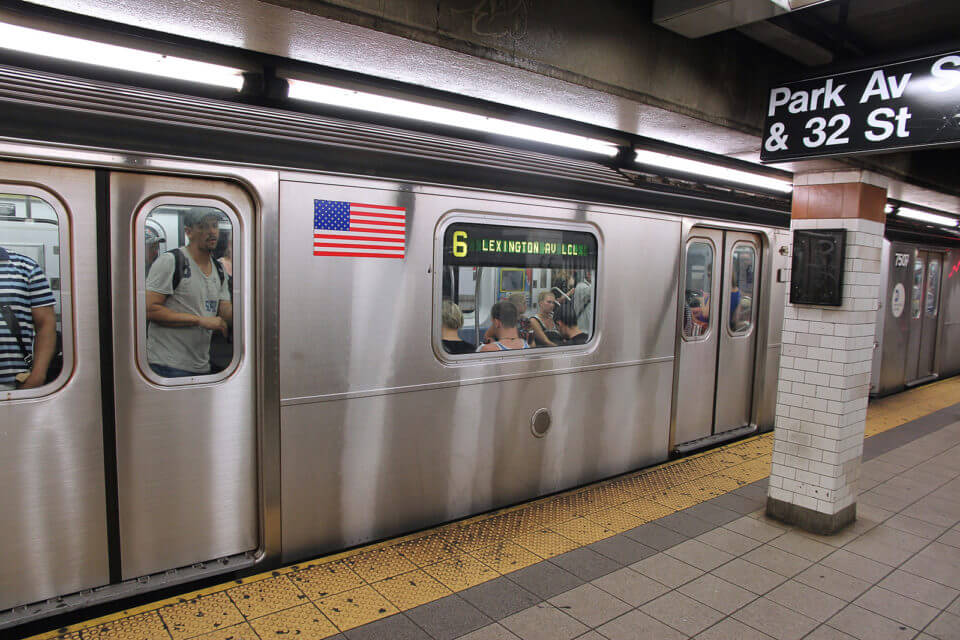
“And we very much do need to start telling ourselves and these street people the hard (but ultimately more humanizing and compassionate) truth again: We need to call the bums by their rightful name.”
As a white-collar professional living and working in New York City, I am, as you might well imagine, acquainted with the usual contingent of wealthy urban white liberal professionals. Knowing—or sometimes just sensing—that I am not entirely one of their tribe, they have asked me, on more than a few occasions, a question akin to the following: “So do you know what things are like on the subway nowadays? I must say I haven’t been on since Covid.” Like you were ever really on it even before Covid, I would think to myself, smiling with polite bemusement, as I prepare to describe to them the city in which they supposedly live.
Most people are lazy and stick pretty close to home, both physically and intellectually. The poor and working class, at least, usually have to commute to work and run errands that they cannot outsource to a courier and are also more likely to socialize and play outdoors due to the more confined nature of their living quarters. In contrast to the working class’s generally more unmediated experience of life, rich liberal elites typically live an insulated existence in which their interactions with their surroundings are mediated by doormen, nannies, delivery boys, cleaning ladies, dog-walkers, waiters, drivers, and other lackeys and intermediaries. They stay largely confined to the few square blocks in their vicinity in which they might walk their dogs when they do not have someone else do it for them, and when they undertake longer journeys, they have parking attendants summon their hibernating vehicles up from their garages and make a beeline straight for the nearest highway leading to their country getaways in the Hamptons and beyond. On account of these differences, poor and working class people are far more likely to have a realistic apprehension of what the nooks and crannies of their neighborhoods and their cities are actually like, both during the day and at night, whereas our typical wealthy urban liberals are completely dependent upon rumor mills comprised of their like-minded friends and acquaintances and, even worse than that, what they might be told by the insular media streams they tend to consume.
“Do you mean how are things on the subway as far as Covid or as far as crime and general mayhem?” I respond.
“Both, I guess.”
“As far as Covid, it’s totally safe, in my opinion. I’ve been taking the subway three or four times per day the whole way through. Back in March and April 2020, it was pretty empty, just me and homeless bums, so it was easy to stay spaced out. When the MTA started closing the subway down at night for deep-cleaning, the bums couldn’t sleep there anymore, and then it was really just me and a few other eccentrics and brave souls; it was empty to an almost creepy extent, but it was actually safer than it’s been in years. And then they reopened it at night, and the bums and druggies started coming in en masse. The subway’s decently crowded now again, but I don’t think it’s dangerous from a Covid standpoint. From what I’ve read, there’s not much evidence of transmission on the subway (or even in restaurants). It’s mostly happening at home. But from the standpoint of crime and public disorder, it’s become an utter madhouse.”
“I don’t know what you’ve heard or read,” I continue, as my interlocutor stays quiet, adjusting his business casual shirt collar, beginning to grasp, perhaps, that he was getting somewhat more than he had bargained for, “but it was already starting to happen before the pandemic, when Mayor de Blasio started pulling cops out of the subway and our wonderful D.A.s started ignoring quality of life-type crimes, so all hell broke loose. Day by day, the situation degenerated until we were seeing the makings of an epidemic of misbehavior, smoking on the subway, feet on the seats, aggressive panhandling, music blasted out loud, bums splayed out everywhere, all sorts of unwelcome bodily excretions, and turnstile jumping by the very kinds of people we don’t want in the system because they not only cost us hundreds of millions in lost fares each year but also are the ones who break all the other rules and commit crimes and so on. And then Covid happened, and everyone was now stuck at home with little or nothing to do, socially isolated, facing all sorts of stress and strain, so we got meth and fentanyl all over the place. Neighborhoods like the East Village became pretty scary to walk through for awhile. All the regular college kids and fratboys who live there weren’t around anymore, and many of the businesses were closed, especially in the evenings. Instead you had these druggie bums lounging around in various states of semi- or un-consciousness everywhere. It was an open drug scene. Other neighborhoods, like Chelsea and Hell’s Kitchen, became dangerous and stayed dangerous. And when the city opened up again and the subway went back to round-the-clock service, the rot and dysfunction all moved down there as well.”
“Covid probably also made life difficult for a lot of people from a financial standpoint.”
“You know, I don’t think that has much to do with it, actually. I know more than a few people, consistent with the reports of ‘the Great Resignation,’ who were sitting at home collecting Covid payouts and unemployment benefits, while restaurants and other businesses were desperate for workers. And, of course, we had the eviction moratorium that kept getting extended, so it’s not like we suddenly had all these people who couldn’t pay their rent and were now out on the street due to Covid (unless, maybe, they were landlords who couldn’t collect rent but still had to pay their property taxes). No, if you just spend a bit of time looking around on the subway or outside, you’ll see that these people are almost all either totally out of their minds on drugs or else just out of their minds for other reasons. The media gives us a sanitized version of the ‘homeless’ as these poor unfortunates who fell on some hard times, lost a job or something, and then couldn’t make their rent or got priced out of housing due to rising rents and gentrification, and then maybe, once they were already out there, they got into drugs to escape from their harsh realities. But, as Michael Shellenberger explains in his book San Fransicko: Why Progressives Ruin Cities, which came out last year and is rather eye-opening about these kinds of issues, that’s hardly ever what actually happens in these situations. There are very few people who are on the street because they got priced out of housing. Those kinds of people find roommates or move to cheaper zip codes or go stay with family until they can piece things back together again. The ones who end up on the street are almost invariably the ones who went on a downward spiral because of drug addiction or chronic untreated mental illness. These are the people who can’t go stay with family either because no one can deal with them anymore or because they don’t want mom and grandma seeing them completely nutso on drugs or else because they need to be out there near the open-air drug scenes where they can get their fix. And then they start panhandling or engaging in shoplifting and other petty crimes to fund their habits. There’s space available in shelters, but shelters have a curfew and a no-drug-use policy, naturally, so these people don’t want to be there. They’d rather be near their dealers. As you can imagine, these bums are generally not super industrious and motivated to trek out too far to meet their needs. You’ll hear from the career homeless advocates that shelters have no privacy, no peace and quiet, and occasional violence, but it all makes very little sense when you stop to think about it for a moment: Are you really getting more privacy, more peace and quiet and more safety when you’re sleeping on a subway car, station bench, or city sidewalk?”
“Okay, okay, I think I see where you’re comin’ from,” I hear, and I interpret the generic acknowledgment as the guy crying uncle, so I leave my lecture off there. But there is more I could add, the still-more-salty bit that would surely get me branded persona non grata in this khakis-and-cardigans milieu.
What Shellenberger explains is that some of these cities—he focuses on San Francisco, largely, which is the worst of the lot, but New York is getting there too—have allowed the situation to degenerate by implementing policies that give the bums what they want without building in any accountability. Instead of a system of ratcheted-up benefits and rewards in exchange for staying out of trouble, going to rehab and sticking with it, our cities started letting public spaces be overrun with bums and addicts, tolerating open drug scenes, failing to prosecute quality-of-life crimes and more recently—in order to avoid overdose deaths—even setting up injection clinics to give the junkies free illegal drugs without so much as making an effort to wean them off their dependencies. This is evil: It is enabling their self-destructive and socially destructive habits. It is akin to setting up giveaways to would-be shoplifters, since if we put them to the pains of actually having to steal, we would be risking explosive confrontations and violence.
Foremost among the policy errors Shellenberger describes is a “housing first” mentality that operates on the false assumption that the primary obstacle these bums and addicts face is a lack of permanent housing, and if only that need were to be addressed, the rest would fall into place. Even the very name “homeless”—now being pushed out in favor of still more absurd terms such as “individuals experiencing homelessness,” “houseless” or “unhoused”—was an ideological construction ushered in by homeless advocates in the 1980s to force us to imagine the obstacle these people face as being merely an inability to afford housing. The terms it replaced—bums, hobos, and the like—were, in fact, far more accurate and socially useful descriptions. Unlike “homeless,” which strips people of agency by conceiving of them as passive victims afflicted by a lack they cannot remedy, these older terms, their moral valence notwithstanding, confer upon people the dignity of conceiving of them as responsible for their own condition and, therefore, armed with the capacity to change their circumstances. You cannot tell someone to stop being homeless, but you can tell them to stop being a bum. And we very much do need to start telling ourselves and these street people the hard (but ultimately more humanizing and compassionate) truth again: We need to call the bums by their rightful name.
And then we need to stop enabling their self-destructive lifestyles. We need to kick them out of our subways, and still more importantly, we need to kick out the political bums—the dug-in advocates and unrepresentative progressive elites—that have brought us to this social precipice. Our new mayor and our governor have announced just recently a promising start: the subways, Mayor Eric Adams said, are for getting from place to place, not for all the antisocial behaviors that have been tolerated there for much too long.
Mayor Adams’ predecessor, Warren Wilhelm, Jr., the man who rechristened himself “Bill de Blasio,” was raised in cushy Norwalk, Connecticut and the People’s Republic of Cambridge, Massachusetts, and in his eight years in office managed to undo much of the hard work Mayors Giuliani and Bloomberg had done in cleaning up New York. He was a poster-child for the very kind of smug, elite, white, out-of-touch, limousine liberal who railed against “a tale of two cities,” even as he would get, literally, chauffeured some 22 miles on an almost daily basis from his Manhattan day job to his Park Slope, Brooklyn gym and back and hardly ever saw the inside of a subway train. He either had no concrete idea how disastrous his pro-crime-and-disorder policies had been for the City, or else he was in denial, or else he simply did not care because his priorities were guided by ideological blinders. Mayor Adams—black, with working-class roots and a former cop himself—has already done a far better job in his first few months in office of at least showing that he sees the City’s problems and cares enough to try to fix them.
Nationally, there is a similar distinction to be made between white American Democrats and black and other minority American Democrats. Only 34% of white Democrats see crime as a major problem, according to a recent Pew survey, while that number is 71% for black Democrats and 53% for Hispanic Democrats. White liberals are far more likely to belong to the particular grouping, representing 8% of the population, denominated “Progressive Activists” by the Hidden Tribes report on American political subgroups, and these Progressive Activists have the highest socioeconomic status of any of our political tribes. They simply do not live in and do not often bother to visit the neighborhoods most affected by crime and poverty and so have hardly any clue of what is going on.
Despite the seemingly vast gulf that separates them, the wealthy white progressive elites and the bums they champion have something in common that distinguishes them from the white and minority working class and the working poor: They tend to be social parasites. They feed and subsist off of the stable social and economic structures created by others. The bums do so in a very direct and obvious way, but the white liberal elites do so more subtly but just as surely: Many of them work in financial sector jobs that create nothing of value but, rather, rake in profits by trading on value created by others. Ask yourself what the typical “investment banker” or “hedge fund guy” and the legions of attorneys and consultants that cater to these nonproductive sectors actually contributes to society. What they contribute to, in fact, is what economists have termed the excessive “financialization” of our economy, making money off of money rather than off of value-creation. While some financialization is necessary to allow for the free flow of investment capital into productive sectors, excessive financialization of the sort we now have results in misallocation of resources, as companies engage in measures such as cost-cutting and share buybacks—rather than in maximizing efficient production and innovation—to increase earnings-per-share and the compensation of top executives. The zero-sum transactions that excessive financialization incentivize merely shift societal wealth up from the bottom to the top of the economic ladder, while ultimately hurting the economy as a whole.
Driven, perhaps, by a subconscious desire to compensate for the social and economic value they misappropriate from us, these parasitic elements and their still more guilt-ridden children born into unearned wealth and privilege then assuage their guilt by posturing themselves as fighters for “social justice,” defenders of the rights of the “most vulnerable and marginalized.” Irony of ironies, the “vulnerable and marginalized” they champion are their mirror-images, social parasites at the bottom of the American totem pole.
What we need is a return to the middle, middle America, the middle class and its sane and sensible traditional middle-class values, not this America of economic extremes that reinforce each other’s worst, most dysfunctional tendencies, while tearing apart the delicate social fabric on which the rest of us depend. Certain recent developments—the moderate Mayor Adams’ Democratic primary victory over the divisive “progressive” anti-cop racial rage candidate, Maya Wiley, the nationwide parental groundswell mobilizing against the politicization of our schools, the recent ouster of three identity-politicking activists from the school board in far-left San Francisco, the nationwide demand for action on crime afflicting our cities—suggest the tide is finally turning in our favor. But we cannot let up, not until our nation regains its robust sense of the daily reality in which we actually live, as against the ideological fantasies spun out by the holed-up, walled-in wingnuts in their palatial penthouses, ivory towers, and havens in the hills.
Alexander Zubatov is a lawyer in New York, as well as an essayist and poet.










